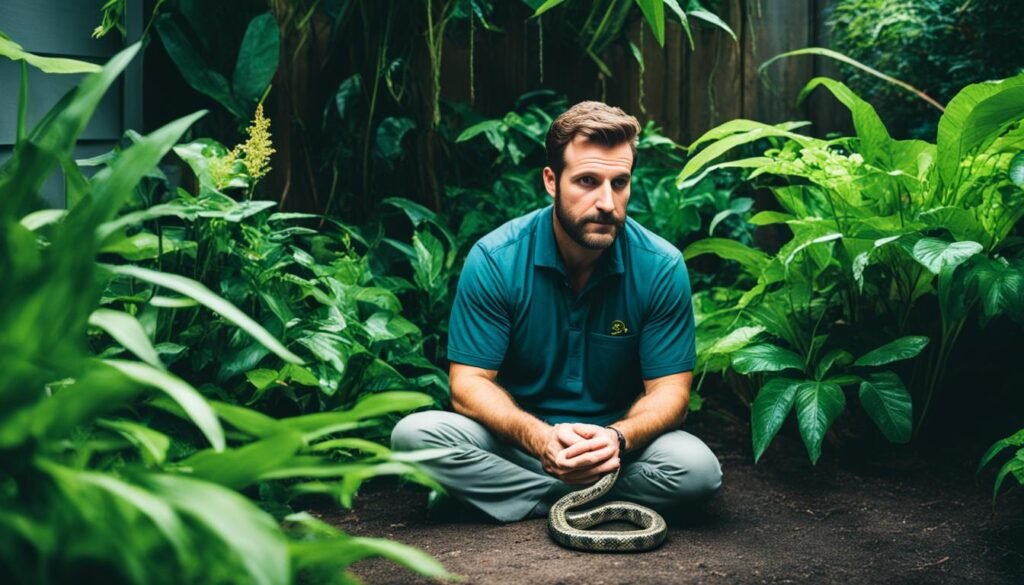You know, what is the world’s largest harmless snakes? Finding a snake in your yard can be scary at first. But, many snakes are not harmful and are key to the environment. Garter snakes, rat snakes, and green snakes do a great job of keeping pests away in gardens.
Seeing snakes might worry you. However, knowing which ones are safe helps you see their value. If your yard has water, bushes, or rocks, snakes might call it home.
Learn about the harmless snakes around you. This can help you live well with them and make your yard better for all wildlife. With some understanding, you’ll see these backyard creatures as helping, not harming, nature.
Understanding the Role of Snakes in Your Backyard Ecosystem
Snakes are often feared, but they are key to keeping backyard ecosystems in balance. They are part of the natural world, being both predator and prey. Knowing this, we can welcome snakes in our backyard and help the environment.
Snakes as Natural Pest Control
Snakes are great at controlling pests. They eat many small animals like rodents and insects. This helps gardens and crops, and even protects our homes. Here are some cool facts about snakes and pest control:
- Snakes eat frogs, insects, and rodents, which keeps their numbers down.
- Farm animals help feed about 200 million people by eating those crops that rodents would destroy.
- Rats spread diseases like leptospirosis and hantavirus, but snakes help keep their numbers low.
The Importance of Snakes in Maintaining Ecological Balance
Snakes do more than just control pests. They also balance the ecosystem by serving as food for birds and mammals. This process supports a healthy, diverse environment. Here’s why snakes are important for nature’s balance:
| Ecological Role | Importance |
|---|---|
| Biodiversity | Snakes help maintain biodiversity by controlling the number of prey. |
| Food Chain | They are crucial in the food chain, getting eaten and also eating others. |
| Ecosystem Services | Snakes help plants spread by dispersing seeds, which is important for plant growth. |
Understanding the role of snakes in your backyard can lead to a better, balanced environment. They’re not just pests control but also a vital part of the life cycle in our world. Reconnecting with snakes means supporting our entire ecosystem.
Common Non-Venomous Snakes Found in Backyards

In your backyard, you might see various non-venomous snakes. These snakes help keep the ecosystem balanced. Garter snakes, rat snakes, and green snakes are among those you might find. Each has its own unique habits, making them interesting to watch from afar.
Garter Snakes
Garter snakes are small to medium-sized. They have three stripes that help you spot them easily. These snakes can live pretty much anywhere, from backyards to water areas. They are not harmful and eat things like insects, frogs, and worms.
Rat Snakes
Rat snakes are great climbers and can grow up to 5 feet long. They help by controlling the rodent population. You’ll notice their dark colors, often black or gray, with light patterns. Even though they look big, they’re not dangerous. They help keep your garden free of pests.
Green Snakes
Green snakes are known for their bright green color. They are friendly and can be found in places with lots of plants. These snakes are quite small, usually 12 to 22 inches long. They eat insects and are safe around people and pets.
| Snake Species | Average Length | Venomous | Habitat |
|---|---|---|---|
| Garter Snake | Less than 39 inches | No | Backyards, gardens, near water |
| Rat Snake | Up to 5 feet | No | Woodlands, fields, backyards |
| Green Snake | 12 to 22 inches | No | Gardens, shrubs, vegetation |
Knowing about these snakes and their habits can help you welcome them in your yard. Remember, they’re not looking to bother you and will move off if they can. Living together with these harmless creatures lets you enjoy nature up close.
Identifying Harmless Snakes
Knowing which snakes are harmless helps us live well with these friendly creatures. You can tell them apart by how they look and act. This keeps you safe and them respected.
Physical Characteristics of Non-Venomous Snakes
Non-venomous snakes look different from venomous ones. Here’s how you can spot the safe ones:
- Round pupils, unlike the vertical, cat-like pupils of venomous snakes
- Absence of heat-sensing pits between the eyes and nostrils
- Slender, elongated bodies compared to the thick, heavy bodies of venomous snakes
- Smooth, tapered heads that blend seamlessly into the neck, lacking the distinct, triangular shape of venomous snake heads
- Longer, more slender tails in contrast to the short, thick tails of venomous species
Just note, non-venomous snakes might look a bit like the dangerous ones. For instance, Eastern Hognose snakes can puff up to seem venomous. Always know what snakes live near you to be sure.
Behavioral Differences Between Venomous and Non-Venomous Snakes
Watching how a snake acts can tell you if it’s safe or not. Here’s what harmless snakes do:
- Fleeing or trying to get away from people
- Making a bad smell or pretending to be dead to scare off attackers
- Shaking their tail quickly, which might sound like a rattlesnake’s warning sound
Venomous snakes, however, are usually more ready to attack if they feel threatened. They might:
- Curl up and get ready to strike
- Hiss or show their teeth to warn you off
- Bite fast to defend themselves
| Venomous Snake Behavior | Non-Venomous Snake Behavior |
|---|---|
| Standing their ground when threatened | Fleeing or attempting to escape |
| Coiling and raising head to strike | Displaying defensive behaviors (musking, playing dead) |
| Hissing or gaping mouth to reveal fangs | Vibrating tail rapidly to mimic rattling |
| Quickly striking or lunging forward | Flattening body or head to appear larger |
Knowing these differences helps with snake safety. Remember, any snake, venomous or not, might bite if scared. Stay back and don’t touch snakes unless you know how. We can share our space with these cool animals by being careful and respectful.
Benefits of Having Harmless Snakes in Your Backyard
Bringing in harmless snakes to your backyard has lots of good points. It makes the area healthier and more in balance. These snakes help control pests like rodents and insects. Without them, these pests could cause a lot of harm and spread diseases.
Snakes aren’t just good at getting rid of pests. They’re also an important food source for many animals. Birds of prey and other creatures rely on snakes. Having them around helps keep the ecosystem diverse and stable.
Having snakes means you might not need as many chemical pesticides. They naturally keep the pest numbers down. Less pesticides are better for everyone, helping protect beneficial insects and birds. It’s a win for both people and nature.
| Snake Species | Pest Control Benefits |
|---|---|
| Garter Snakes | Control slug populations, mitigating damage to plants |
| Rat Snakes | Consume rodents, preventing property damage and disease spread |
| Green Snakes | Feed on insects, helping to maintain a balanced insect population |
Most backyard snakes are harmless. They’re not a danger to humans. Yet, many people fear them. It’s interesting that more people are scared of snakes than is needed. Understanding the benefits of these snakes can help us get over our fears. Then, we can live well with them and value their place in our backyard world.
Creating a Snake-Friendly Backyard Habitat
To live well with non-venomous snakes and appreciate their role, it’s key to set up a home they like. This involves natural hiding spots, a balanced environment, and no harmful chemicals. Doing so will make your yard a happy place for these helpful reptiles.
Providing Natural Shelter and Hiding Spots
Snakes need safe havens to hide and warm up. To make your yard ideal for them, add these shelters:
- Log piles, old stumps, or dry creek beds offer safety and shelter
- Rock walls or large rocks give them sunny places to heat up
- Brush piles or leaf clutter are perfect for hiding and hunting
- Ground-level water sources like birdbaths provide drinking and soaking spots
Maintaining a Balanced Ecosystem
A balance in your yard is needed to attract and help snakes. They are natural pest controllers. For a good ecosystem:
- Grow various native plants and have hiding spots for snakes
- Host insects and small animals as snake food by planting different flowers
- Avoid harmful chemicals that upset the ecosystem
Avoiding the Use of Pesticides and Chemicals
Pesticides are bad for snakes and their friends. To be snake-friendly, avoid using these toxic chemicals. Instead:
- Use natural ways to grow your garden whenever you can
- Stay away from strong pesticides that can hurt all animals
- Prefer eco-friendly methods like removing pests by hand or attracting their natural enemies
| Snake-Friendly Habitat Element | Benefits for Snakes |
|---|---|
| Log piles, old stumps, or dry creek beds | Provide shelter and hiding spots for snakes to rest and feel secure |
| Rock walls or large rocks | Offer basking spots for snakes to regulate their body temperature |
| Diverse native vegetation | Creates natural corridors for snakes to move through safely |
| Avoiding pesticides and chemicals | Preserves the health of snakes and their food sources in the ecosystem |
Putting these tips into practice helps create a warm home for friendly snakes. You’ll also enjoy their help in keeping pests away naturally.
Coexisting with Harmless Snakes

It’s important to live peacefully with all backyard creatures, including snakes. These snakes are helpful for the environment. By knowing about them and being cool with them, you’re helping out everyone.
Understanding Snake Behavior and Body Language
Snakes usually like their space and don’t want problems with us. When you see one, watch how it acts. This shows if it’s calm or if it’s worried. A scared snake might hiss or get ready to strike, while a chill one will just calmly go away.
Snakes don’t mean us harm. They’ll only bite if they have no other choice. If we can tell what they’re feeling, we can avoid getting too close. This means we can all live together without scaring each other.
Giving Snakes Space and Respecting Their Presence
If a snake is in your yard, just let it be. Don’t try to scare it off or catch it. This could make the snake feel threatened and act out. Just watch from far away and admire it.
Snakes actually help by eating pests like rats. So, letting them live around your place is a good thing. Make sure your yard has spots where they like to hide. This way, they can keep helping the yard stay balanced and healthy.
| Snake Behavior | Interpretation | Appropriate Response |
|---|---|---|
| Calm, slow movement | Snake feels safe and unthreatened | Observe from a distance, allow the snake to retreat |
| Coiling, hissing, raising head | Snake feels threatened or defensive | Give the snake space, avoid sudden movements |
| Rapidly fleeing | Snake is frightened and seeks to escape | Allow the snake to retreat, do not pursue |
By knowing about snakes and leaving them alone, we can all get along. This helps the yard and lets us appreciate the nature around us even more.
Debunking Common Myths and Misconceptions About Snakes
Snakes have been the center of many myths. These myths cause a lot of fear and misunderstanding about these interesting reptiles. Many think all snakes are dangerous to people because they’re venomous. But, in truth, only a small portion of snakes, about 7%, are venomous enough to hurt or kill humans.
Some also believe snakes are ready to attack people. This idea is completely wrong. Snakes usually avoid people and only bite if they’re scared and can’t run away. In the United States, there are very few snakebite deaths each year, even with thousands of bites reported.
A big mistake is thinking we can tell if a snake is dangerous by how it looks. The color or shape of a snake’s body isn’t a reliable way to know if it’s venomous. This wrong idea can lead to dangerous situations with snakes. For more about these debunked myths, visit Wildlife SOS.
Speaking of facts, did you know snakes don’t control their body temperature like we do? They rely on outside sources for warmth or coolness. Snakes also eat large meals, thanks to their jaw structure, like Burmese pythons eating deer. Their jaws stretch a lot without breaking.
| Myth | Fact |
|---|---|
| Snakes are slimy | Snake scales are smooth and dry to the touch |
| Snakes can hear like humans | Snakes detect sounds in a range of 50 to 1,000 Hertz, compared to humans who can hear between 20 and 20,000 Hertz |
| Snakes seek revenge | Snakes do not have the capacity for complex emotional responses like revenge |
More wrong ideas exist, like snakes dancing to snake charmers’ music (they don’t). Also, traditional remedies can’t heal snakebites; the best course is timely anti-venom treatment. Pisces Pets provides insight on these myths.
It’s important to debunk myths and really learn about snakes. This helps us all understand and value these animals better. Unmasking the myths is key in saving snakes and living peacefully with them in our environments.
Educating Children About the Importance of Snakes

Kids are naturally curious and this includes wanting to learn about snakes. If we teach them how important snakes are in our world, we can make them care more about these creatures. It’s key to talk about snakes in a positive way. This is because kids might copy their parents’ fears or dislike of snakes. This could make things dangerous if kids think badly about them.
Teaching Children to Appreciate and Respect Snakes
Explaining the big role snakes have in nature is a must. They help keep the balance by being food for other animals and showing us how healthy nature is. This way, kids get why snakes matter and learn to respect them.
Here’s what to focus on when talking to kids about snakes:
- Snakes are protected by law in many regions, such as Australia, where it is illegal to harm them under the Nature Conservation Act 1992.
- Most snakebites happen when people scare them, so it’s best to leave snakes alone.
- In winter, snakes slow down and may seem asleep. This helps them save energy.
- Snakes are most active in the spring, after the cold weather, when they need to eat and find mates.
Engaging in Safe and Supervised Snake Encounters
Tell kids to watch snakes from far away and never touch them. A good way to learn is by visiting a place where they can see snakes safely, like a nature center or a zoo.
If kids see a wild snake, they should:
- Stay calm and not scare the snake.
- Wait for the snake to leave on its own.
- Slowly walk away from where the snake is once it’s gone.
Playing games about being safe around snakes can help kids remember what to do. Learn about first aid for snakebites too, just in case.
| Snake Safety Tip | Explanation |
|---|---|
| Wear closed-in shoes in snake-prone areas | Good shoes can help protect against snake bites |
| Make vigorous movements when walking | Walking loudly can warn snakes you’re there, so they won’t be scared into attacking |
| Leave snakes alone | Most bites happen when people try to touch or scare snakes |
By showing kids that snakes are important and deserve our respect, we help them grow up to be friends of snakes. Teaching them well and safely about snakes means they understand why these animals are key to our world.
What to Do if You Encounter a Snake in Your Backyard
Finding a snake in your yard can be quite startling. But remember, most of them are not dangerous. Wildlife experts say that many backyard snakes are safe. The chance of a venomous snake biting you is much lower than the risk of a bee sting.
Remaining Calm and Giving the Snake Space
Seeing a snake in your yard may make you want to panic. But staying calm is key. Most snakes just want to get out of sight. So, give it room to slip away.
Non-poisonous snakes can act scary when scared. They might hiss or shake their tails. But they’re only trying to protect themselves.
Killing or catching the snake is not wise. It can increase the chance of it biting you. Snakes are good for the environment. They help keep pests in check. If you want it to leave, gently guide it with water from a distance.
Contacting a Professional for Removal if Necessary
If you’re worried about the snake, especially if it might be venomous, get help. Professional snake handlers can safely move it. This keeps both the snake and your family safe.
When choosing help, look for pros who care about the snake’s well-being. They should use caring methods. In places like Florida, you can find trained wildlife removers.
| Snake Encounter Scenario | Recommended Action |
|---|---|
| Non-venomous snake in a low-traffic area | Give the snake space and allow it to leave on its own |
| Snake of unknown species or in a high-traffic area | Contact a professional snake removal service for safe relocation |
| Venomous snake in any area | Keep a safe distance and immediately contact a professional for removal |
Learning to coexist with snakes is important. By understanding them, we can prevent problems. Education helps us live peacefully with snakes in our environment.
The Role of Snakes in Folklore and Mythology
Snakes have always been important in stories and beliefs around the world. They mean a lot to us. Since ancient times, humans have told tales and made myths about snakes, keeping their memory alive for thousands of years.
Cultures often link snakes to starting life and creation. One example comes from ancient Greece. There, Nüwa, a snake with a woman’s head, made people from clay. The first people were noble, and each creation after was less so. The feathered serpent Quetzalcoatl in Mesoamerican beliefs also helped make the world.
Many see snakes as wise, knowledgeable, and powerful. For Hindu, Buddhist, and Jain faiths, the Naga were important. They were part human, part snake, and guarded sacred sites. This showed their connection to ancient wisdom and valuable secrets.
| Culture | Snake Mythology and Folklore |
|---|---|
| Norse | Jormungand, the sea serpent, was depicted as encircling the Earth and played a significant role in the final battle of Ragnarok. |
| Greek | Medusa and the Gorgons were snake women with the power to turn people to stone with their gaze. |
| Native American (Hopi) | The Snake Dance ritual is performed to encourage rainfall and fertility, involving the handling of live snakes during the ceremony. |
| Chinese | The Legend of White Snake tells the story of a white snake demon taking human form, highlighting themes of love and transformation. |
Some cultures see snakes as connected to the afterlife and dead. The Serer people from West Africa believe in souls becoming black snakes before going to Jaaniiw, their afterlife. Snakes were seen as eternal in the ancient Dahomey kingdom for their power to shed skin and live again.
Religions and spiritual beliefs have snakes too. Some Christians, especially in mountain churches, include snake handling in their worship. They believe snakes can be mystical awakenings or signs of God.
Despite both good and bad views, snakes are a lasting part of human culture and beliefs. They make us feel many things – intrigue, fear, and respect. Their place in our stories and legends shows just how deep their impact is on us.
Conclusion
In conclusion, we’ve seen how important harmless snakes are in our yards. They help keep our environment balanced. By living peacefully with them, our ecosystem can flourish. Remember, only a few snake species are harmful to us. Many, like sea snakes and kraits, rarely cause harm despite their venom, as National Geographic tells us.
To help harmless snakes, create a friendly place for them to live. Follow tips from Medium’s article on coexisting with wild. Make sure your yard has places for snakes to hide, find food, and drink. Keeping your yard chemical-free is also important. This makes sure snakes and their food have a safe home.
Learning about snakes is key to getting along with them better. By teaching people the facts about snakes, we can live together peacefully. The Odd Gumnut’s personal encounters show that respect and knowledge are crucial. With more understanding, we can enjoy a diverse backyard where all creatures are safe. This includes snakes, which are beneficial to our environment.
FAQ
Are all snakes in my backyard venomous?
No, most snakes in backyards are not dangerous. They include garter snakes, rat snakes, and green snakes. These snakes are harmless to people. They help the environment by eating mice and bugs.
How can I tell the difference between venomous and non-venomous snakes?
Non-venomous snakes often have round pupils and no heat-sensing pits. They also lack triangular heads and appear longer and slimmer. However, staying away from all snakes is safest unless you know a lot about them.
What are the benefits of having harmless snakes in my backyard?
Harmless snakes are good for your yard. They eat pests like rodents and insects, which helps your garden. This reduces the need for pesticides that can harm the environment. Snakes also add to the variety of wildlife in your yard.
How can I create a snake-friendly backyard habitat?
To make your backyard snake-friendly, add places for them to hide. This includes brush piles and rock walls. Planting native vegetation will attract their food. Using natural pest control is better than chemicals.
What should I do if I encounter a snake in my backyard?
If you see a snake, stay calm and give it room. Don’t try to touch or trap it. For snakes you can’t recognize and in busy spots, professional removal may be wise.
How can I educate my children about the importance of snakes?
Teach kids to watch snakes from afar without disturbing them. Safe visits to nature centers can help them learn. They should learn how to stay safe around snakes, like knowing how to spot a dangerous one.
Are snakes aggressive towards humans?
No, snakes are not usually aggressive. They don’t look for humans to bother. They’ll only bite when they feel scared and have no way to escape. Giving them space helps everyone stay safe.
Do snakes have slimy skin?
No, snakes don’t feel slimy. Their scales are smooth and dry. Some snakes look shiny, which might make people think they’re wet.
What role do snakes play in folklore and mythology?
Snakes are important in stories and beliefs around the world. For example, in Egypt, Wadjet was a snake god known for protection. In Greek myths, snakes represented healing and wisdom. Native Americans often saw snakes as symbols of life and change in nature.
Why is it important to have snakes in our backyard ecosystems?
Snakes are key to keeping our yards in balance. They eat pests, helping gardens and lowering disease risks. In this way, they make our environments healthier and more varied. Respecting and welcoming snakes means we can live well with them.













